Text
8. The great firewall of China
It’s pretty crazy to think that we live in a world where censorship of information is a thing. And that China has blocked their citizens from using websites such as Google, Facebook and Twitter. China has completely blocked access to most of the global internet “as a part of a sweeping crackdown aimed at suppressing dissent and maintaining the Communist party’s grip on power.”

China operates the largest internet censorship regime in the world, blocking access to thousands of websites.
But millions of Chinese citizens go against China’s censorship system, known as the Great Firewall, by using a VPN, allowing unfettered access to any website. This censorship has forced the citizens of China to come up with their own forms of social medias. Instead of WhatsApp, they have WeChat. Instead of Twitter, they have Weibo. Twitter was blocked because it was used to organise protests which the Chinese government didn’t like. Weibo is pretty much exactly the same as Twitter in the sense that it has the limited word count and people share their daily thoughts with hashtags etc, but is not used to discuss politics like we usually see on our Twitter feeds. Instead of Google, they have Baidu. Whilst most of these newly created apps have the same similarities and uses as the world popular apps like Google and Twitter have, the price is that its hundreds of millions of Chinese users pay for using apps like these as all their information is shared with the government.
China also has their own type of YouTube, where anyone can upload their own videos but they are all monitored by the Chinese government. Therefore anything criticising the Communist Party is taken down.
Even though the use of social media and online websites is restrictive, a study found that the usage of Chinese social media is expanding greatly. A Boston Consulting Group study found that Chinese Internet users are online for an average of 2.7 hours per day. The reasons for this may be:
rural-to-urban migration that has separated families
the loneliness of the one-child generation
a distrust of information from government-controlled media
It’s a bit mind boggling to me that if I were to live in China pretty much my every move on the internet is being monitored and shared with the government. It has a scary resemblance of George Orwell’s novel 1984, which come to think of it might be banned in China too?
Research shows that China has the least online freedom of the 65 countries monitored by rights group Freedom House. “It says China’s internet controls have reached “new extremes.”
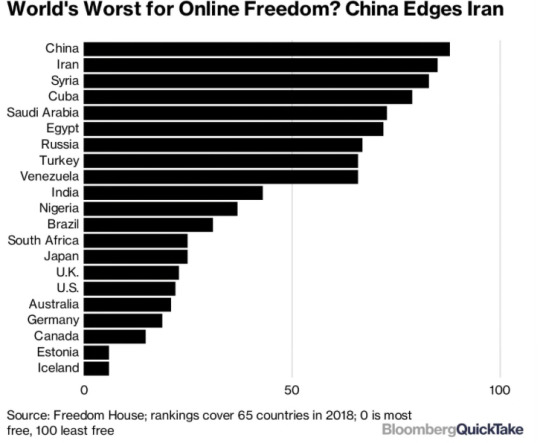
People have been arrested for posting comments that the government doesn’t condone, things are being banned constantly, such as children’s book character Winnie the Pooh as he has apparently a comparison to President Xi Jinping. Even the new Disney movie ‘Christopher Robin’ was banned by the government as bloggers online created a parody comparing the bear to the president.
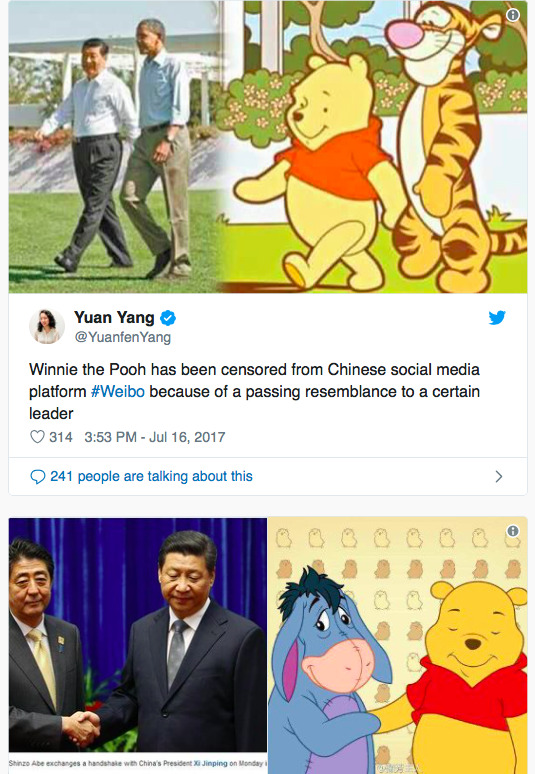

References:
ABC News, 2018, Winnie the Pooh movie Christopher Robin banned in China after comparison to President Xi Jinping, viewed 25 May 2019 <https://www.abc.net.au/news/2018-08-08/winnie-the-pooh-film-christopher-robin-banned-in-china/10088446>
BBC Newsbeat, 2017, social media censorship in China: how is it different to the West?, viewed 25 May 2019, <http://www.bbc.co.uk/newsbeat/article/41398423/social-media-and-censorship-in-china-how-is-it-different-to-the-west>
Bloomberg, 2018, The Great firewall of China, Washington Post, viewed 25 May 2019, <https://www.washingtonpost.com/business/the-great-firewall-of-china/2018/11/05/5dc0f85a-e16d-11e8-ba30-a7ded04d8fac_story.html?noredirect=on&utm_term=.48e62c08a521>
Crampton, T 2011, Social media in China: the same but different, China Business Review, viewed 25 May 2019 <https://www.chinabusinessreview.com/social-media-in-china-the-same-but-different/>
The Guardian, 2017, China moves to block VPNs from 2018, viewed 25 May 2019, <https://www.theguardian.com/world/2017/jul/11/china-moves-to-block-internet-vpns-from-2018 (Links to an external site.)>
2 notes
·
View notes
Photo
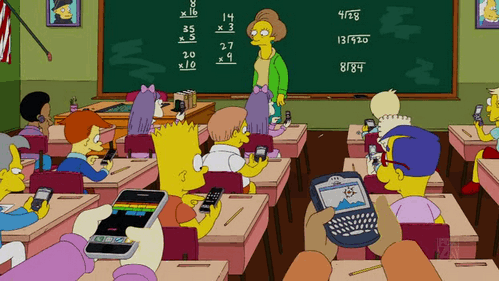
“Even the technology that promises to unite us, divides us. Each of us is now electronically connected to the globe, and yet we feel utterly alone.”
785 notes
·
View notes
Photo
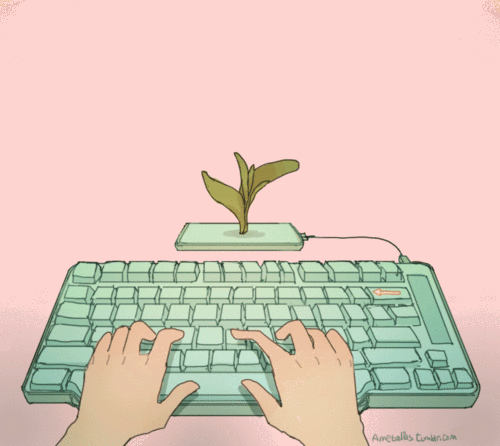
flowers wilt and die, but my words to you last forever
6K notes
·
View notes
Text
7. Social and online gaming
Confession: I have never played Sims, Moshi Monsters or Club Penguin.

Growing up we never had a laptop or computer at home so, my online gaming pretty much consisted of Poptropica at school and Mathletics.... And even then my favourite thing to do on Poptropica was to make my avatar rather than play the actual game.

There was also that time Candy Crush was a thing. Remember that?
Game producers such as Zynga, the makers of FarmVille (that game all of your weird aunties on Facebook still play? and send you requests to help them grow some corn? yeah that one) and King, the makers of Candy Crush, realised that they could profit from using social networking sites like Facebook.
Personally I always found it annoying when games on my phone asked me to ‘share this on Facebook to gain more points’ or ‘refer 3 friends on Facebook to unlock this level’. At this point I would stop using the game altogether because it was socially unacceptable to ask your friends to help you unlock that extra level on Candy Crush when they stopped using it months ago. #guiltypleasures
So, with my established lack of knowledge when it comes to gaming, you can imaging my surprise when finding out about the game ‘Second Life’ in the lecture. A simulation (mimicry) where players are escaping from themselves and becoming ‘illusory characters’ that are not at all like them in real life.
Second Life is an online virtual world, developed and owned by the San Francisco-based firm Linden Lab and launched on June 23, 2003.
In the case study of ‘Dave Barmy’ and ‘Laura Skye’ talked about in the lecture. The couple met online in the virtual world of Second Life and decided to get married in Second Life, after meeting in real life the couple married. However, Dave’s avatar had an affair in Second Life which resulted in the real life couples divorce.
The game was making money as people were so invested in the game. Users would create their own ways such as making gowns for the avatars or selling real-estate to make real money. Users would use their real money to buy skins and clothes etc for their online avatars. This concept is now used in many games such as Fortnite. The amount of times my brother has come to my mum asking for her credit card details to buy something on that game is ridiculous.
Gaming is a form of entertainment. All people from teenage girls and boys, to young toddlers and grown adults all play games as a form of escapism or to pass the time.
The reasons for the growing popularity of online gaming are because of the accessibility, there are games on pretty much every mobile device or computer. There is also an availability of different games to choose from and something for everyone. Online gaming is sociable, if someone doesn’t have anyone to play with they can play against their friends or strangers online.
However, the downside to any online gaming world is the continuation of the games becoming monetized. The games become more about the profit that companies can make from them rather than enjoying the game itself. It also creates another platform for online trolling and cyberbullying to occur. It makes young kids vulnerable to hate and trolling that they should not be subjected to in the first place. Not long ago there was an outbreak of the ‘MoMo’ trolling. Where an anonymous person using MoMo as a cover would place this horrifying character unexpectedly in children’s videos and games and telling the children hateful and scary things. To the point where they were too afraid to go online anymore, which is not what the online gaming community is meant to be like.
0 notes
Text
6. Public Health Campaigns on social media.
To make any campaign successful these days, there has to be some form of social media campaign and it has to trend so people talk about it. This unexpectedly happened back in 2014 with the ALS Ice Bucket Challenge. I was in year 10 at the time, and of course I participated in the challenge, it was all over my Facebook and I was nominated by a friend. Young and naive me thought that tipping some cold water on my head was really helping the cause. In a way it was, I was spreading awareness just like the other people in my year level but I think maybe 1 out of 10 people actually would have donated to the cause at my school.
Within one month of the Ice Bucket Challenge being created, more than 17 million people had posted videos of them pouring ice cold water on their heads. From celebrities to young kids, it was all we saw on our social media and it turned into a trend. Celebrities like Lady Gaga, Benedict Cumberbatch and Jimmy Fallon all took part. As a result the ALS Association raised over $115 million to continue with research and spreading awareness about the disease.
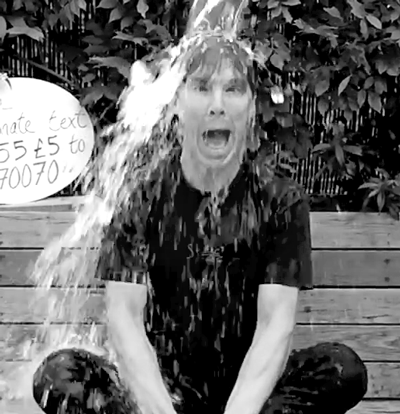
The Ice Bucket Challenge was a one hit wonder on social media, but it was a successful campaign.
There is one campaign that is almost synonymous with the month of November. (Hint: starts with m, ends in ovember)
‘Movember’, one whole month where we get to see our dads, grandpas, prepubescent brothers and our friends grow a filthy stache all in the name of men’s health.

The Movember Foundation spreads awareness on men’s health issues such as prostate cancer, testicular cancer and mental health. Movember has raised over $700 million to fund 1,200 men’s health projects. The audience for this campaign expands year to year with more men continuing to “wear this campaign on their faces” and spread the word by sharing photos and fundraising on social media.
Social media has opened up a new way of reach. Public health campaigns are so important to society and spreading awareness on important issues.
However, there is a negative side in regards to mental health on social media and that is obvious now. However, it was not as obvious to people a few years ago. With all these new social media platforms popping up when I was in high school, I admit that my parents did not know the half of it. Now that I am older, I realise how important it is as a parent or as a person to be fully aware of what is out there on the internet that kids and teenagers are looking at. While I don’t agree that we need to be controlled online, I think that we need to be educated.
I remember in the early stages of high school tumblr was all the rage and almost every teenage girl in my grade had an account. Some of us shared our url’s with each other and some kept them private. I had one account where I had a few friends follow me and a few classmates as well, but there was also an additional account that was completely private to me. Whilst the ‘hipster, boho and natural aesthetic’ was all anyone wanted to achieve on their blogs, there was also a hidden dark side to tumblr. One that had a continuos flow of dark and depressing images and posts. It blows my mind to think that I ever looked at these perfectly curated dark, ‘black and white’ blogs and thought that they were good for me to express my inner sadness and express my ‘feelings’, when in reality they were harming my well being and mental health. The content was ‘manicured, curated content’ that ‘belies or even engenders personal anxieties and depression.’ (McCosker, 2015) The content I was seeing glorified and beautified mental illnesses and made me unaware of the real issues that people with these sicknesses actually dealt with, but it also made me feel the negative thoughts as well.
When I finally came to realise the vicious cycle of scrolling through the depressing images was not good for me, I was already down the rabbit hole. But I knew that I needed to delete the account to feel better. But many teenagers might not have come to that realisation. I had a lot of friends with similar issues, they would turn to their blog for help rather than seeking it in the real world. In reality, the blog just made things so much worse for them.
When I think back to myself a few years ago, I wish I knew what I know now. It is so important to talk about our feelings with loved ones and not isolate ourselves to the ‘darker’ sides of the internet.

References:
Walgrove, A, 2019, 5 viral nonprofit campaigns and what you can learn from them, Canva, viewed 7 May 2019, <https://www.canva.com/learn/5-viral-nonprofit-campaigns-can-learn/>
McCosker, A 2016 'Digital Mental Health and Visibility: Tagging Depression', in P. Messaris and L. Humphreys, Digital Media: Transformations in Human Communication (2nd edn), Peter Lang click here
0 notes
Text
students skipping school to demonstrate for our planet

1K notes
·
View notes
Text
5. Crowdsourcing.
Crowdsourcing is the practice of engaging a ‘crowd’ or group for a common goal. It is powered by new technologies, social media and the web.
Crowdsourcing is all around us, and new definitions are being added everyday. It was something that I never really thought about until reading about the topic.
Uber is crowdsourced transportation, Uber eats is crowdsourced transportation of food and Airbnb is crowdsourced accommodation. Crowdsourcing is used in our everyday life, if we realise it or not.
Crowdsourcing can involve obtaining work, information or opinions from a large group of people who submit their data via the internet, social media and smartphone apps. It allows companies or people to get a variety of skills and expertise without necessarily having to pay the normal overhead costs of employees.

Social media is public, relevant, responsive and accessible, so it makes sense that we should be using our platforms for the greater good.
Some brands may use their online audience for an opinion on a product or new design. This is a quick and easy way to get a diverse opinion from a variety of cultural and socioeconomic backgrounds, rather than paying for a small focus group.
Crowdsourcing holds such a potential to help in times of crisis. Using the power of the Internet and social media to virtually harness the power of individuals and bring them together in support of a disaster, has successfully been used in different ways over the years.
Social media can play a big role in disaster recovery. Facebook recently included the safety check-in post, where people can let their loved ones know immediately if they are safe in a zone if they are located in an area that potentially has a natural disaster or some other form of crisis.
We can use our platforms to play an important role in disaster management and communication. A major crisis requires help from organisations, individuals and society as a whole. This could include citizen journalism, to spread the word from the goings on at the disaster and people ‘retweeting’ or sharing donation pages for those in need.
For example, after the 2010 Haiti earthquake, the people of the Twitter community took it upon themselves to translate other Tweets from the disaster location to other languages to assist the emergency responder teams. Twitter is now becoming multilingual and will be translating tweets in other languages as a result of this.
Or using our social media to create visibility on a disaster, if people didn’t post their own photos, videos and other forms on content on social media, sometimes i don't think the world would ever see what’s really happening. Non-Authoritative statements and information often emerges a lot faster than authoritative statements. The immediate coverage of a disaster is crucial for public knowledge, which creates response and recovery. However, the issue with the non-authoritative crowdsourced information is that it needs significant filtering. People can and will post anything and it can create a lot of unnecessary ‘noise’.
Positive and negatives of crowdsourcing:
Positives:
Cost savings
Speed
ability to work with people with different skills and expertise
gathering research
dividing up tasks
Negatives:
Damage Business Reputation
misinterpretation of information
non-authoritative information circulates faster than authority information
References:
Kearns, K, 2015, 9 great examples of crowdsourcing in the age of empowered consumers, Tweak your Biz, viewed 5th May 2019 <https://tweakyourbiz.com/marketing/9-great-examples-crowdsourcing-age-empowered-consumers>
Kenton, W, 2018, Crowdsourcing, Investopedia, viewed 5thMay 2019, <https://www.investopedia.com/terms/c/crowdsourcing.asp>
World Vision, 2010 Haiti earthquake: Facts, FAQS, and how to help, viewed 5thMayb 2019, <https://www.worldvision.org/disaster-relief-news-stories/2010-haiti-earthquake-facts>
0 notes
Text
4. Digital citizenship and trolling.
The subject of trolling and online bullying is a topical issue for most people. In particular, with children being on the internet at a much younger age that other generations are used to. This sparks an argument on whether letting children use the internet is a good or bad thing and how we can protect the innocent from the nasty online trolls and bullies.
What is an online troll?
In 2002, one of the earliest definitions of internet “trolling” was described as: “luring others online (commonly on discussion forums) into pointless and time-consuming activities” (March, 2019)
However, now it is more commonly associated with definitions such as intentional, malicious online behaviour.
Or
Intention of attacking, offending or purposely causing discomfort of offence
Or
Deliberately commenting on a post to elicit a desired response, or to purely gratify oneself by emotionally manipulating another.
All recent definitions of ‘trolling’ have one thing in common and that it that it is cyber abuse. When we think of ‘troll’ we think of the ugly creature living under a bridge, and this imagery downplays the seriousness of the negative online behaviour. The reality is that this behaviour is a form of abuse. (March, 2019)
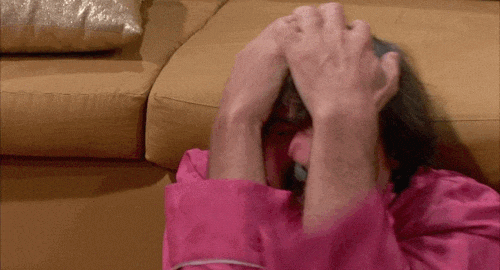
Why do they do it?
It doesn’t seem logical to me that people would spend their days scrolling through the internet for the soul purpose of writing horrible things to make someone feel bad. But the anonymity of the internet makes it so easy for them to do so. However, unfortunately these negative behaviours aren’t just coming from anonymous strangers.
We live in a new world now where even our schools aren’t safe. The bullying is no longer just on the playground, but kids will go home from school only to be met with negative comments online as well. The fact is, the internet is becoming a dark and negative place and people are starting to accept this as the norm.
The problem in schools is that students operate under the assumption that a divide exists between the real world and the digital world. This divide is our online identity and our true selves. We all have different online identities on every different platform we involve ourselves with, but it is up to us to behave in the right way on those platforms with our chosen identity and not let the digital world have different morals and rules to our real one.
In the education world, it is often a teacher’s instinct to shut down the cyberbullying behaviour when it happens and filter everything. However, it is up to everyone to educate people on good digital citizenship and spread awareness of the dangers on living in an online world. (Piercey, 2017)
Recently on talk show Ellen, singer Pink was a guest. She was talking about how she often posts pictures of her children on her account and how she lives on a farm and she wants them to be free and sometimes they are naked and that’s just what happens sometimes. She was then overwhelmed by death threats, horrible comments saying that she is a terrible mother for not putting a diaper on her child and threats to call child services. The result was that she came to the decision to not put any photos whatsoever of her children on her social media accounts because it really damaged her emotionally.
Just because the internet is free for everyone, people think it is their right and that they are entitled to have an opinion on everything. The only thing we can do to stop this epidemic of negative people making the internet a dangerous place is to not feed their behaviour.
What can you do?
Ignore their messages or block and report them when you can.
Make light of the situation, use humour to make them know that you aren’t hurt by their comment. Trolls fed off of emotions.
Unmask them when you can. By taking away their anonymity you take away their power.
Create a unified community or support system.
Fight back with facts and correct mistakes made.
(Rampton, 2015)
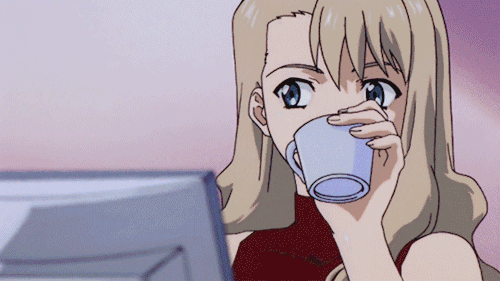
References:
March, E, 2019, Online trolling used to be funny, but now the term refers to something far more sinister, The Conversation, viewed 22ndApril 2019, < https://theconversation.com/online-trolling-used-to-be-funny-but-now-the-term-refers-to-something-far-more-sinister-110272>
Piercey, D, 2017, Trolls, Catfish, Cyberbullies – Oh My! How to help students stay ‘Internet Kind’, EdSurge, viewed 22ndApril 2019, < https://www.edsurge.com/news/2017-07-06-trolls-catfish-cyberbullies-oh-my-how-to-help-students-stay-internet-kind>
Rampton J, 2015, 10 tips to dealing with trolls, Forbes, viewed 22ndApril, https://www.forbes.com/sites/johnrampton/2015/04/09/10-tips-to-dealing-with-trolls/#1cc3c42c54f4
1 note
·
View note
Text
3. Activism and Protest on social media.
If there is any form of activism or protest in the world, usually social media is the first way that I find out about it. Posting about an issue on social media platforms allows for quick circulation and gets a lot of attention fast. However, the only issue with putting things on Facebook or Twitter is that it makes it easy for people to simply ‘like’, comment or share the post, rather than participating in the real change. Yes, there is progress in numbers and sharing awareness of a certain issue, but the real change happens when we actually do something about it.
And... I am a guilty member of the social media world by showing my support by simply ‘liking’ the post. However, this ends up being an empty gesture as it isn’t going towards productive change.
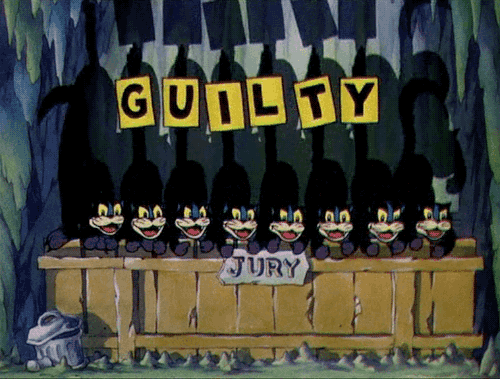
Digital activism is based on the digital network. Our networked publics on our social media platforms allows us to connect with other global voices and link with one another to send and receive original content, coordinate action, and as a result create effective political movements.
Social media can be used as a political echo chamber or public sphere, so that people can use it to connect with others of similar political mindsets.
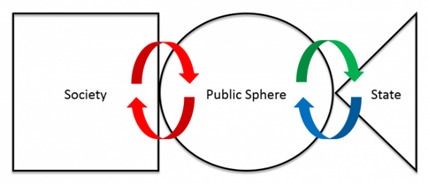
Activism and Protest on social media:
Social media has radically transformed activism. Decades ago, it would take weeks of planning, newspaper ads, phone calls or flyers to organise a successful protest. Whereas now a Facebook post or a tweet on Twitter could fill a few streets or city. (The Associated Press, 2018)
“With the rise of social media, it’s a lot easier for people to mobilise more quickly.” However, you still need a powerful message that resonates with a lot of people. (The Associated Press, 2018)
“Activists are now able to push back, mainly through social media and provide channels for multiple voices in ways that simply were unavailable on a large scale 50 years earlier” (The Associated Press, 2018) However, this doesn’t mean that the message always gets through to where we want the message to end up or achieve.
With so many of us from diverse and different socioeconomic backgrounds, social media makes it difficult for a respected leader to emerge from the online protest as it frequently attracts criticism, trolling and personal attacks. It makes it extremely difficult to stay on message when there are people personally attacking your every word.
However, when acts of protests are done right, they can be powerful movements in history. For example, the #MeToo movement went viral all around the world and stayed the way for some time.
The #MeToo movement/hashtag was created to express solidarity with the victims of sexual harassment and abuse. It was a remarkable movement because the huge amount of replies to this hashtag spoke volume of how prominent sexual abuse is.
According to Facebook, within the 24 hours of the first post, over 4.7 million people worldwide had used the hashtag and there were over 12 million posts, comments and likes. (Zilles, 2018)
This movement shows how the one powerful voice of actress Alyssa Milano could influence many other voices to speak up on social media and create a movement to spark change.

I applaud all the women and men that took part in this movement to spark positive change in an issue that needs to be addressed.

References:
The Associated Press, 2018, Social media is the new heart of political protests, Wtop, viewed 16thApril 2019, < https://wtop.com/social-media/2018/06/todays-protests-many-voices-social-media-not-1-leader/>
Zilles, C, 2018, The #MeToo movement shows the power of social media, Social Media HQ, viewed 16thApril 2019, < https://socialmediahq.com/the-metoo-movement-shows-the-power-of-social-media/>
0 notes
Text
2. Politics and social media
It’s no secret that Australian politicians having social media accounts helps them to engage with their voters, especially the younger generation. However, when I see a meme about a politician or something they have posted on social media it makes me question their credibility.
Whilst I was doing some research on the current Prime Minister ScoMo as he likes to be called, and I discovered this post.
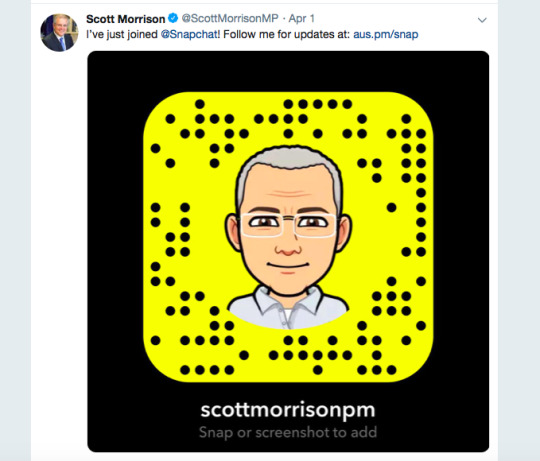
Now, I don’t know about you, but discovering ScoMo as a bitEmoji made me think....

I can agree that having a social media campaign would be helpful to gain voters and for politicians to get their key messages out there into the world. However, there will always be a backlash to anything they post and that’s uncontrollable.
In some ways, the backlash of social media posts can alert people to the wrongdoing. An example of this would be the recent Fraser Anning egging, that became a large topic of conversation across all social media platforms. It wasn’t the egging that was the topic of conversation as such, more so Fraser Annings response to it and #eggboy was trending in a matter of minutes.
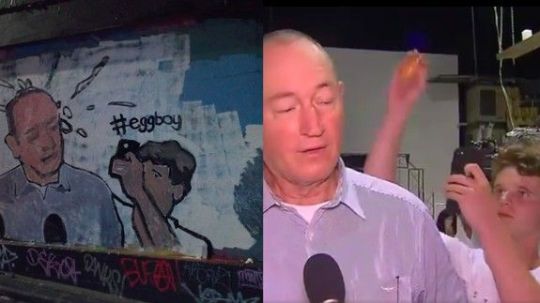
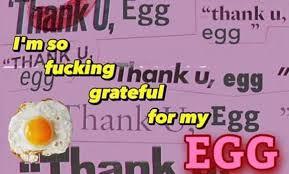
It is moments like these that a reputation can be ruined in a matter of seconds because social media circulates the news so quickly. Politicians need to be aware of their voice and the way social media works in order to use it successfully to their gain.
Social media and the Public Sphere
Social media platforms connect millions of users digitally. This has prompted some to argue that social media has promoted the return of Habermas’s Public Spheres. Habermas (1998) defines the public sphere as a place where “private people come together as a public” for the purpose of using reason to further critical knowledge which, in turn, leads to political change. (Kruse et al, 2018, p.63)
However, social media creates additional barriers to civil political discourse therefore making it even less likely that political discussions will remain civil on social media platforms.
While social media can be a “powerful platform for ordinary citizens to expose wrongdoing and mobilise. But on the other, it is a platform for peddling lies, xenophobia and propaganda.” (Trounson, 2016) Social media has the potential to engage young people like me into the importance of politics, however, that is only if we want it to. Social media can be used as a powerful tool for the general public to speak up and protest about issues that they want solved in our government. A great example of this was the postal vote for same-sex marriage. There was a large amount of discussion on social media about the issue and it gained a lot of attention.
Another example of politics on social media is the hashtag #auspol, a hashtag that tends to trend on and off around the world and not just in Australia. Short for Australian politics, the hashtag is used for commentary and rumour spreading about the going ons of the federal government. #Auspol is not only used as a link to the conversations about the topic on Twitter, but it is also used as a community of people that like to discuss, argue (civil or non civil) and talk about their opinions. This is an example of the public sphere. (Mashable, 2016)
Social media will play a role in Australian politics for the foreseeable future, it is however, up to us to use this platform in a way that is productive and sparks meaningful change. I think if we keep speaking up for issues that we believe in and use social media as a means to get our voice heard then it will be effective in the long run.
References
Andrew Trounson, Social media politics: for and against, Election watch 2016, The University of Melbourne, viewed 8th April 2019, <https://electionwatch.unimelb.edu.au/australia-2016/articles/social-media-politics-for-and-against>
#auspol: The Twitter tag that Australia can't do without, Mashable March 6 2018 https://mashable.com/2016/03/21/twitter-australia-auspol/#4tvfXtsZUEqV (Links to an external site.)Links to an external site. viewed 8th April 2019
Kruse, LM Norris, DR & Flinchum, KR 2018, Social media as a public sphere? Politics on social media, The Sociological Quarterly, 59:1, 62-84
1 note
·
View note
Text
1. Is Tumblr a blog or a social network site?
What is Tumblr you ask?
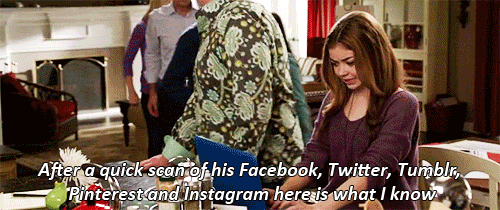
Tumblr is the type of social networking site you go on when you really don’t want your closest friends and family to follow you. On this site you can create a personal online identity that doesn’t necessarily even need to have your face or name on it. You can come up with a weird and wacky URL like @pineapplebreadman or @onceuponawilddream… and come up with an equally weird and wacky blog content genre to go with it. And let’s get real here… Tumblr has some deep and dark places around every corner which means there is something for everyone…. and I mean everyone.

To define Tumblr as a social networking site or a blog, there can be some blurred lines. If you google ‘what is Tumblr’ it will say that it is a microblogging and social networking website founded by David Karp in 2007 and owned by Verizon Media. People usually use Tumblr to ‘reblog’ or post original content of images or small amounts of text. However, there would be some blogs out there such as fanfiction blogs that use their Tumblr platform as more of a blogging style as they are posting mainly text-based posts. Therefore, Tumblr could be considered both a social networking site and a blog.
I think Tumblr is a type of social media platform that is different to Twitter, Facebook or Instagram as it has a certain anonymity behind it. People don’t have to put their face or name to their blog and they have a freedom to post whatever they want, whether it be a hidden identity in their real life or not. People can use this platform as an outlet of self expression that they might not be able to do on their other social medias such as Facebook. They can be whoever they want to be and Tumblr creates a ‘mask’ for their real identity.

This is what had me drawn to Tumblr in the ‘prime time’ for the social networking site during 2013. It was during this time that I had my own account, with only a small group of friends that knew about it. We would all follow each other and aim to create that ‘beachy, boho, hipster aesthetic Tumblr famous blog’, meanwhile having a growing obsession for all things One Direction. I think there has been a dramatic decline in the way that Tumblr is used today, compared to how it used to be. I remember it being so easy to find custom made free themes on Tumblr back in the day. Me and my friends would spend sleepovers looking for cool themes and completely making over our blogs and scrolling through our feeds and reblogging. One of my friends had 10k followers so we would do promo competitions where she would get her followers to follow us and then she would give them a shoutout... ah the simpler times. Nowadays, Tumblr is mimicking blogging websites like WordPress and introducing paid themes.
Tumblr uses affordances from other social networking sites such as the ‘like button’ and the ‘hashtag’, by using these affordances it means it is using other aspects of social networking sites and therefore is a social networking site itself. By using an affordance such as they hashtag, it can create subcultures and communities within the platform that allow users to find common ground with other users, therefore conversing socially.
I think it is hard to define whether it is a blog or a social network, it all depends on what the user is wanting to use the platform for.
(all gifs sourced from Tenor.com)
3 notes
·
View notes


